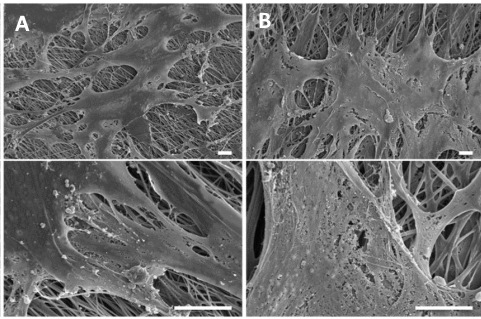Kartogenin (KGN) is a small, non-toxic, heterocyclic molecule, it has been known for effectively enhancing the chondrogenic differentiation of human bone marrow MSC (hBMSC), for exhibiting chondroprotective effects in vitro and for reducing cartilage degeneration [1].
KGN interacts with the actin-binding protein filamin A, disrupting its balance with the transcription factor core-binding factor β (CBFβ), giving it the ability to enter the nucleus and interact with RUNX1 to form the CBFβ-RUNX1 complex that activates the transcription of chondrogenesis-related proteins and enhances cartilage ECM synthesis [1].

In a recent study, it has been speculated that KGN released from coaxial aligned electropsun nanofibers in a controlled manner would promote hBMSC chondrogenesis. To access the bioactivity of the released KGN it was used the evaluation of KGN-loaded electrospun scaffolds ability to promote hBMSC growth and chondrogenesis. The experiments showed that KGN-loaded electrospun scaffolds promoted sGAG production and chondrogenic gene expression when compared to the respective non-loaded scaffolds, a promising result for the regeneration of the cartilage superficial zone. [3].
This outcome highlights the potential of KGN-loaded aligned nanofibers for the development of novel biomimetic MSC-based strategies to regenerate articular cartilage.

This article was written by Elisa Bissacco as part of an ongoing series of scientific communications written and curated by BioTrib’s Early Stage Researchers.
She is studying a PhD in Tribological Characteristics of Nanofibrous Electrospun Materials at ETH Zurich.
References:
[1] Johnson K, Zhu S, Tremblay MS, Payette JN, Wang J, Bouchez LC, Meeusen S, Althage A, Cho CY, Wu X, Schultz PG, A stem cell-based approach to cartilage repair, Science. 336 (2012) 717–721. doi:10.1126/science.1215157.
[2] Cartilage Extracellular Matrix Scaffold With Kartogenin-Encapsulated PLGA Microspheres for Cartilage Regeneration, Front. Bioeng. Biotechnol. (2020)
doi:10.3389/fbioe.2020.600103
[3] Silva J, Udangawa R, Mancinelli C, Kartogenin-loaded coaxial PGS/PCL aligned nanofibers for cartilage tissue engineering, Mater Sci Eng C Mater Biol Appl. (2020) 107: 110291.
doi:10.1016/j.msec.2019.110291.
